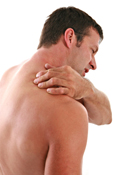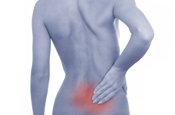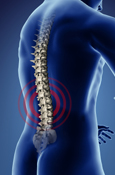

Body Conditions - Back
Skull
Occipital Neuralgia
Occipital neuralgia is a neurological disorder characterized by inflammation and/or injury to the occipital nerves, which span from the base of the neck to the scalp. Treatment for occipital neuralgia may include rest, over-the-counter painkillers, or prescription medications, with surgery reserved for the most severe cases.
Cervical Headaches
A cervical headache begins by the neck and radiates to the skull. Treatment methods for cervical headaches include acupuncture, massage, and/or training to improve neck posture.
Migraine/Tension Headache
Headaches are a common condition affecting over 45 million people each year. Over-the-counter painkillers can successfully treat most headaches, while severe cases may require prescription drugs.
Neck
Disc Herniation
A thoracic herniated disc occurs as a result of trauma or natural disc degeneration, and often presents no symptoms; when present, symptoms typically consist of pain radiating around the chest. Back immobilization, medication, or surgery may be used to treat a herniated disc.
Spinal Stenosis
Spinal stenosis is a common condition involving a narrowing in one or more areas of the spine, causing pain in the legs, back, neck, shoulders or arms. Conservative treatment methods, such as physical therapy, anti-inflammatory drugs, rest or a back brace are usually sufficient for treating spinal stenosis, with surgery only necessary for the most severe cases.
Osteoarthritis
Osteoarthritis is a degenerative joint disease in which the cartilage cushioning the joint slowly wears away, causing discomfort and stiffness in the affected area. Most cases of osteoarthritis can be managed through a combination of painkillers and physical therapy.
Tailbone
Coccydynia
Coccydynia refers to pain and inflammation affecting the coccyx, or tailbone, which is located between the buttocks. Treatment for coccydynia includes sitting in seats with sufficient padding and painkillers.
SI Joint
Sacroiliac Joint Dysfunction
Sacroiliac joint dysfunction refers to inflammation of one or both of the sacroiliac joints, which link the pelvis and lower spine. Treatment for sacroiliac joint dysfunction may include medication and physical therapy; surgery is rarely necessary to treat this condition.
Arthritis
Arthritis is the inflammation of one or more joints, causing pain, stiffness, and other uncomfortable symptoms. Treatment for arthritis can often be achieved through conservative measures, such as exercise, weight loss, or cortisone injections; surgery is rarely necessary to treat arthritis.
Thoracic Spine
Compression Fracture
Compression fractures occur when bones weaken, typically as a result of old age, causing mild to severe pain. Pain medication, rest and bracing are usually sufficient for treating compression fractures.
Disc Herniation
A thoracic herniated disc occurs as a result of trauma or natural disc degeneration, and often presents no symptoms; when present, symptoms typically consist of pain radiating around the chest. Back immobilization, medication, or surgery may be used to treat a herniated disc.
Scoliosis
Scoliosis is an abnormal curvature of the spine, which often occurs with no symptoms, although it may cause uneven shoulders, leaning to one side, prominent shoulder blade or fatigue. Mild cases of scoliosis may be remedied by bracing, while spinal fusion surgery is typically required for severe cases.
Lumbar Spine
Arthritis
Arthritis is the inflammation of one or more joints, causing pain, stiffness, and other uncomfortable symptoms. Treatment for arthritis can often be achieved through conservative measures, such as exercise, weight loss, or cortisone injections; surgery is rarely necessary to treat arthritis.
Disc Herniation
A thoracic herniated disc occurs as a result of trauma or natural disc degeneration, and often presents no symptoms; when present, symptoms typically consist of pain radiating around the chest. Back immobilization, medication, or surgery may be used to treat a herniated disc.
Compression Fracture
Compression fractures occur when bones weaken, typically as a result of old age, causing mild to severe pain. Pain medication, rest and bracing are usually sufficient for treating compression fractures.



